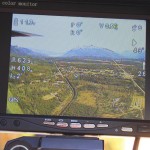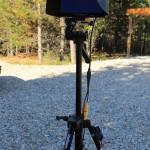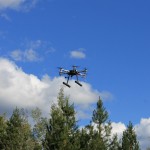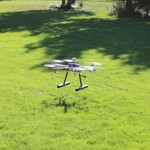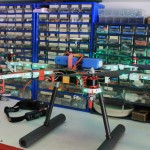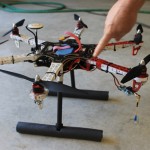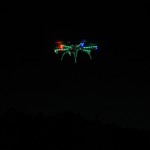By: Korie Marshall
At least one of the strange lights seen overhead by Valemount residents and visitors has been identified – it’s from a multi-rotor remote control helicopter. John Salt knows, because he built, programmed and flies it.
“I honestly didn’t think in this day and age when RC aircraft are so prevalent, that people would actually consider it an unidentified flying object, but I thought I better clear up any misunderstandings and give it some ‘identity’,” Salt said in an email to the Goat. He says the high output LED lights give a big visual footprint in the night sky, but his machine is only about half a meter or so in size.
Salt says it is a DJI F550 Hex-rotor RC helicopter with autopilot and stabilization features build in. It has a flight range of about two kilometers, will fly up to 75k per hour, and he pilots it using video goggles and an on-board camera.
A resident of Valemount for eight years, Salt is an avid RC aircraft hobbyist and runs a website to help educate the public about the hobby – everything from how to build and fly them to safety precautions and responsibility. He doesn’t sell equipment, but makes money off ads and selling books. His main reason for building the website was to help educate those new to the hobby, and others who just want to understand aspects of it better. After he saw the story in the Goat about mysterious floating lights, he contacted us and offered to do a demonstration to prove it, and to clear up the misinformation. Salt also won’t back down from a discussion that is becoming a touchy subject – safety of other aircraft, especially the ones that are human sized.
Salt insists the term “drone” is a misnomer. A drone is capable of flying itself, whereas remote control aircraft are flown from the ground, using cameras mounted on the machines – known as “First Person View” or FPV flying. The technology is not yet available to allow the operator to see in high definition, though Salt admits you can mount something like a GoPro camera on the machine to record while on the flight. You could even use the camera as your guidance system, but the view you get back on the ground is still limited, because the picture is transmitted by radio waves. That also limits where you can fly the machine, because radio frequency is line-of-sight. That means if a tree or a building gets in the way, you lose contact with the remote – and could potentially lose an expensive piece of equipment, along with being responsible for whatever damage it might do. That is one thing Salt stresses – safety and responsibility in the hobby, because he knows the other option is regulation and restriction.
The Goat wanted to see this device in daylight, so Salt invited us to his house, and the first demonstration he gave was something he says you never do – he turned off the control device to demonstrate what happens when his six-propeller helicopter loses contact.
Salt had already pointed out the lights, which he uses primarily for seeing around the helicopter at night. He says flying at night is the safest option here in Valemount, because local helicopters fly visually, so they don’t fly at night. He’d also pointed out the GPS sensor – it has to make connection with seven satellites before the RC will start up. When it takes off, he demonstrates it can do the usual things, like yaw, pitch and rotate, but it automatically hovers in place when the remote is not telling it to move. A gust of wind or even a push will shake it, but it stabilizes itself. The six rotors made a buzzing sound, like a swarm of bees, but the sound fades fast as the helicopter rises.
Just above the height of the trees, a few meters away from where it launched, Salt turned off the controller. We watched a light blink underneath, indicating it has lost contact. After a few moments, it slowly started to come down, and back towards where it took off from. Salt says it is a fail-safe – it will return to the spot it launched from. It pauses a couple of times in air – he says it has a barometric pressure gauge that helps it determine its height. Then it lands within a foot or two of where it took off from – Salt says it’s a better landing than he can do – and turns itself off.
Salt’s next demonstration was the First Person View. This is where he puts on goggles that display the view from the camera, but since I obviously can’t fly it and see through the same goggles, he hooked them up to a screen I could watch. The hex-rotor helicopter quickly rises to a point I can no longer see it in the sky, but I can see what he is seeing through the camera on a shaded screen, about four by six inches big. He shows me how the camera can adjust to see straight down, and how it can get a view of the golf course, or Canoe Mountain and Kinbasket Reservoir, from about 600 meters up.
Flying helicopters is far more fun that flying the winged remotes he started with, says Salt, and easier, since you don’t need a landing strip – just a cleared, level spot to land and take off. He admits the six-rotor helicopters are not that challenging, because of the built-in stabilizers and sensors, but the FPV flying is what interested him.
“It is just like being inside the aircraft. The video goggles give a very immersive flight experience,” says Salt.
During the demos, Salt pointed out some rules of safety, like not flying over people or buildings.
“These aren’t like planes, if anything goes wrong, they go straight down,” he says. That is a risk to anything they might land on – and that risk is the responsibility of the pilot. Salt says he doesn’t fly when the wildfire risk is high because a problem with a battery pack could potentially start a fire, and he doesn’t fly over water, because of the risk of losing his machine – which isn’t cheap.
“Most FPV pilots have a good $1 thousand to $2 thousand hanging up there in the air, so we want to stay out of ‘harm’s way’ as much as anyone else,” said Salt.
After the demos, I asked about the potential risk to other things in the air – like the aircraft that people are actually inside of. Salt says the possible threat of FPV remote controls to full-size aircraft is a “big can of worms.” The issue is a source of heated debate amongst users and critics alike.
“To date there have been no reported mid-air conflicts as far as I know anywhere in the world,” says Salt, and he tries his hardest to keep up to date on it. But he says there is no question, as more of these devices get out there, the risk increases.
“It would be naive to assume it will never happen,” says Salt. He points out that sometimes an idiot will let a cluster of helium-filled balloons go, under a major flight path, so it is possible someone will eventually do something stupid with an RC helicopter.
But in the full-size aircraft world, helicopter pilots are taught to avoid other airborne obstacles. It is called “situational awareness” training, and Salt says it is about concentrating on your surroundings, the same as driving a car, but with a third dimension. Salt says he used to power paraglide here, and was very aware of the potential for helicopters and planes in the valley. Good FPV pilots use common sense and are aware of surrounding air traffic, and Salt almost always uses a hand-held aviation radio to listen to Valemount’s air traffic frequency – something he encourages other FPV pilots to do as well. Even without a radio, he listens for aircraft, and will get his RC well under 500 feet very quickly. He says 500 feet above ground is the minimum safe altitude full-size aircraft can fly over houses and towns, so it’s a pretty safe call. Although he flew over 500 feet for a short period in his demo to show the panoramic views, Salt says he rarely flies over 150 meters (492 feet).
Helicopter pilots can legally fly much lower than that minimum safe altitude though, so Salt admits there is potential for risk if someone is not using common sense.
“Flying RC aircraft has and always will be a privilege – not a right. I try my hardest to get that message across on my site.” Salt says when done with care, understanding and respect, the hobby is safe for everyone. Some manufacturers are even starting to incorporate safety systems, like one RC helicopter that will not take off if you are near an airport, and will not fly above 200 feet. Some people are also working on spatial avoidance systems that will detect another aircraft, and get out of the way if the RC pilot doesn’t do anything.
“The technology is very cool and it’s super fun to pilot,” says Salt, but he acknowledges that conflict safety is ultimately his responsibility – and the responsibility of anyone who flies. Learn more about flying RC aircraft and safety on Salt’s website: www.rchelicopterfun.com



